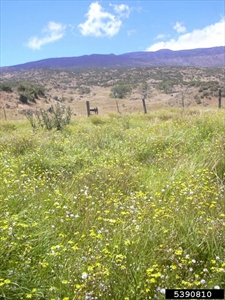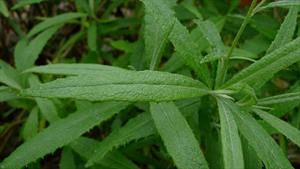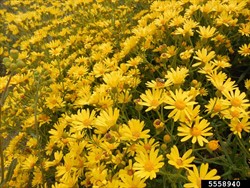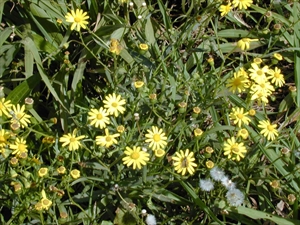Fireweed. It is also known as Madagascar fireweed, Madagascar ragwort.
Pacific Pests, Pathogens, Weeds & Pesticides - Online edition
Pacific Pests, Pathogens, Weeds & Pesticides
Fireweed (501)
Senecio madagascariensis. It is a member of the Asteraceae.
Asia (Japan), Africa, North (Hawaii) and South America, Oceania. It is recorded from Australia. It is a native of Madagascar and southern Africa.
An annual (or short-lived perennial) weed that invades a range of habitats, but particularly pastures with relatively poor soils, poorly grassed (e.g., following a drought) or overgrazed. It is also a weed of cultivated land, open woodlands, grasslands, parks, wastelands, and roadsides. Plants produce seeds 6-10 weeks after germination and one plant may produce 100 flower clusters at one time, and up to 10,000 seeds in a lifetime; at this scale of production there could be a million seeds per hectare!
Plants are erect, 10-60 cm tall, with many branching stems arising from the crown (junction between stem and root). Leaves, alternate along the stem, 2-6 cm long and 3-10 mm wide, fleshy, margins saw-like, without leaf stalks, and base 'clasped' around the stems. Flowers in clusters, daisy-like, 15-20 mm diameter, at ends of stems or in the axils of leaves, bright yellow, with 12-15 outer strap-like ray florets, 10 mm long, and central disc florets. Rows of leaf-like structures (bracts) under each flower cluster. Seeds, 2-3 mm long, covered in lines of short hairs, and ending in a tuff of silky hairs, that acts as a parachute. Root has a shallow branching taproot.
Over short distances by rooting from swollen areas on stem where leaves arise (nodes). Over longer distances by seed on the wind, by animals (e.g., birds and transport of cattle) and on clothing (seeds have hairs that assist attachment, and as a contaminate of hay, other seeds, machinery and vehicles.
Fireweed causes environmental impacts by competing with natural vegetation; However, potential economic impacts are possibly of greater consequence. In Australia, in addition to loss of production from poisoning of livestock due to pyrrolizidine alkaloids, economic impacts include lower carrying capacity, costs of weed management, and lost income from changing from dairy and beef cattle to sheep and/or goats, which have greater tolerance to fireweed toxins. Both acute and chronic poisoning occurs: cattle suffer liver damage, lose weight, and may suffer brain damage; sheep and goats are less affected by the toxins (some sheep breeds are not affected at all, but others may die suddenly), and brain damage is rare; horses are more susceptible and may develop brain damage and skin conditions. Normally, cattle avoid fireweed, but poisoning can occur when paddocks are heavy infested and selective feeding is impossible.
Source of pollen for bees.
BIOSECURITY
The chances of introduction of fireweed is high. Countries not yet infested should consider all likely pathways for entry, and apply quarantine measures accordingly. Particular attention should be given to the risk of contaminated of pasture seed with those of fireweed.
BIOLOGICAL CONTROL
Not a method recommended for fireweed; no natural enemies specific to fireweed known that substantially reduce its impact. Of the pathogens evaluated, the rust, Puccinia lagenophorae, is said to be the most important.
CULTURAL CONTROL
- Physical & Mechanical:
- Hand-pull infestations, if small, but make sure that it is done before the plants seed, and when pastures are growing most rapidly. If plants have seeds, bag and burn them.
- Slashing is not recommended as it only delays flowering and seeding.
- Competitive pastures:
- Maintain a vigorous competitive pasture. Choose a mix of pasture varieties (grasses and legumes) favourable for the area, and do not overgraze pastures. If practical and appropriate apply fertilizer and/or irrigation as required.
-
Livestock:
-
Use sheep and goats to keep fireweed under control, they are 10-20 times less susceptible than cattle (and horses). However, ensure other feed (i.e., pasture species) is available: do not force stock to eat only fireweed.
-
- Hygiene:
-
Treat vehicles and farm machinery. If moving from areas where the weed occurs to those weed-free, wash to remove soil. This is equally important if the machinery is being imported into a country or moved within a country.
-
Purchase only weed-free hay, and use in areas that can be easily monitored for weeds.
-
CHEMICAL CONTROL
In Australia, minor use permits allow the use of: 2,4-D; metsulfuron-methyl; bromoxynil; bromoxynil + aminopyralid; bromoxynil + diflufenican; fluroxypyr + aminopyralid; picloram + triclopyr + aminopyralid. Note, that it is best to spot-spray (if possible) so as not to kill legumes in the pasture.
--------------------
When using a pesticide, always wear protective clothing and follow the instructions on the product label, such as dosage, timing of application, and pre-harvest interval. Recommendations will vary with the crop and system of cultivation. Expert advice on the most appropriate herbicides to use should always be sought from local agricultural authorities.
AUTHOR Grahame Jackson
Information from PIER (2017) Senecio madagascariensis Poir., Asterasceae. Pacific Island Ecosystems at Risk (PIER), Institute of Pacific Islands Forestry. (http://www.hear.org/pier/species/senecio_madagascariensis.htm); and CABI (2019) Senecio madagascariensis (fireweed). Invasive Species Compendium. (https://www.cabi.org/isc/datasheet/49565); and Fireweed (Senicio madagascariensis) (2019) NSW WeedWise. Department of Primary Industries, NSW Government. (https://weeds.dpi.nsw.gov.au/Weeds/Details/53); and DAF (2020) Fireweed Senecio madagascariensis. Queensland Government. (https://www.daf.qld.gov.au/__data/assets/pdf_file/0009/67167/fireweed.pdf); and from Senecio madagascariensis (2016) Weeds of Australia, Biosecurity Queensland Edition. Queensland Government. (https://keyserver.lucidcentral.org/weeds/data/media/Html/senecio_madagascariensis.htm). Photo 1 Forrest & Kim Starr, Starr Environmental, bugwood.org. Photo 2 John Tann Fireweed Groundsel leaves: (https://commons.wikimedia.org/wiki/File:Fireweed_Groundsel_leaves_(8668655194).jpg). Photo 3 Juan Campá, MGAP, Bugwood.org. (https://www.weedimages.org/browse/detail.cfm?imgnum=5558940). Photo 4 John Robert McPherson: (https://commons.wikimedia.org/wiki/File:Senecio_madagascariensis_7th_Brigade_Park_Chermside_IMGP1871.jpg). Photo 5 Forrest & Kim Starr, Photo # starr-001228_0149): (http://www.hear.org/pier/imagepages/singles/starr_001228_0149_senecio_madagascariensis.htm).
Produced with support from the Australian Centre for International Agricultural Research under project HORT/2016/185: Responding to emerging pest and disease threats to horticulture in the Pacific islands, implemented by the University of Queensland and the Secretariat of the Pacific Community.








